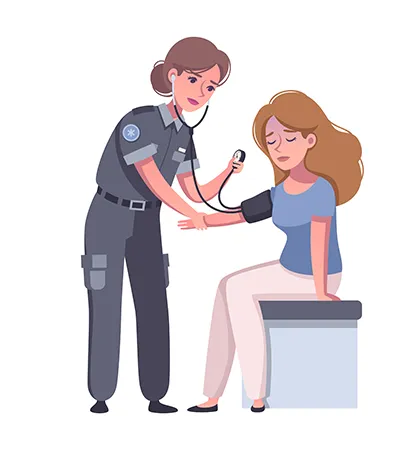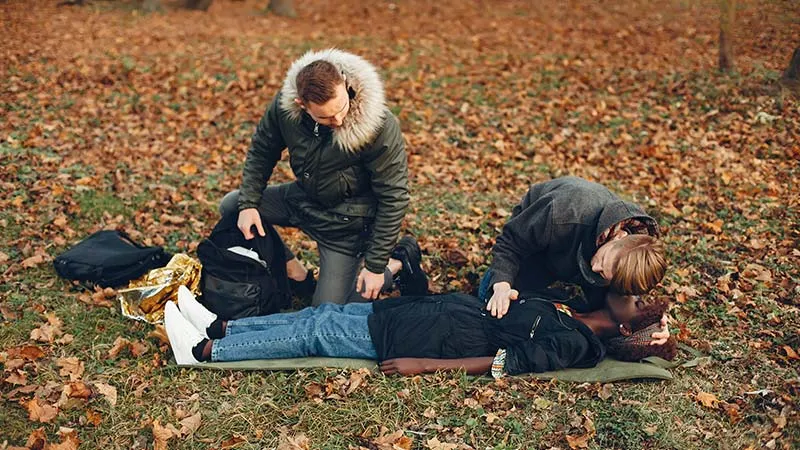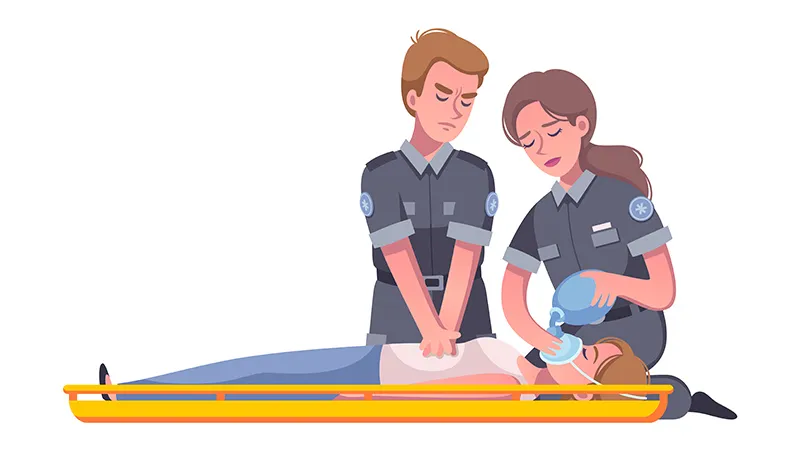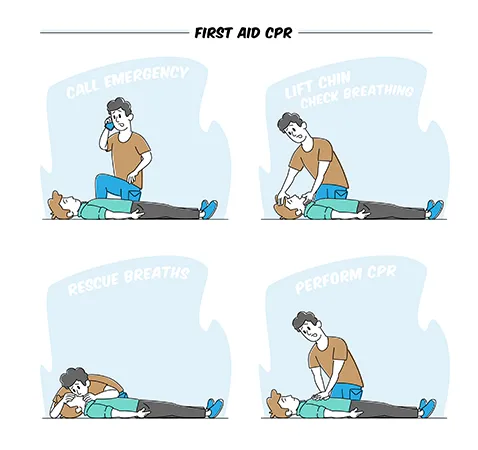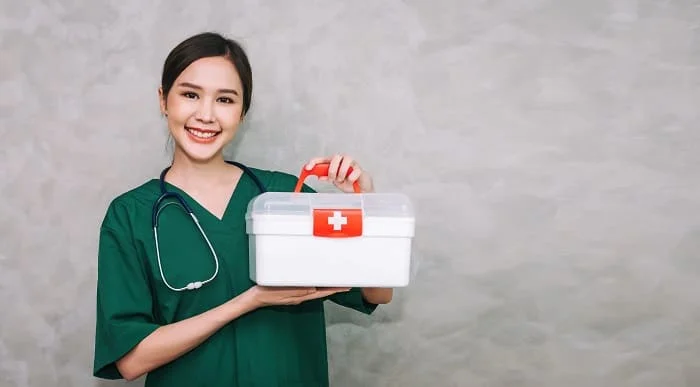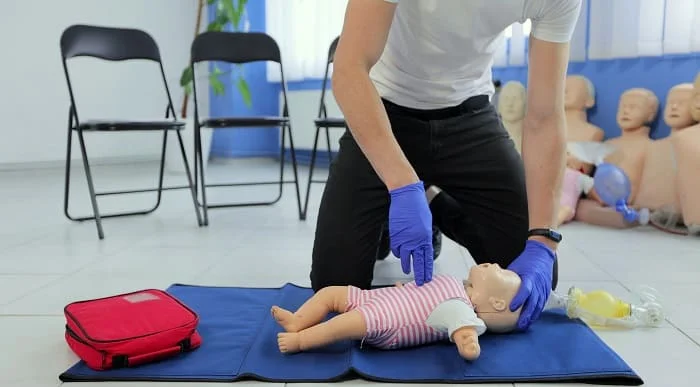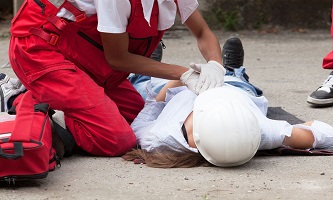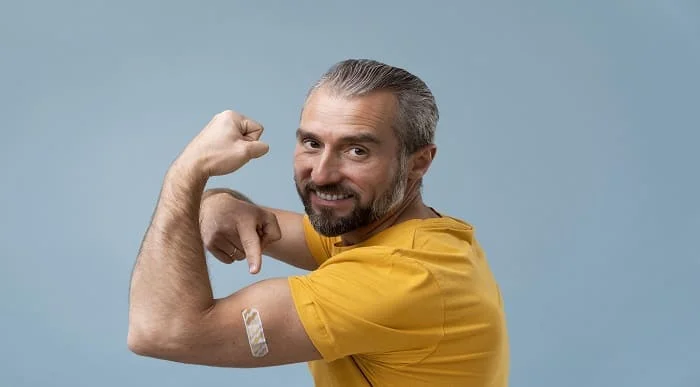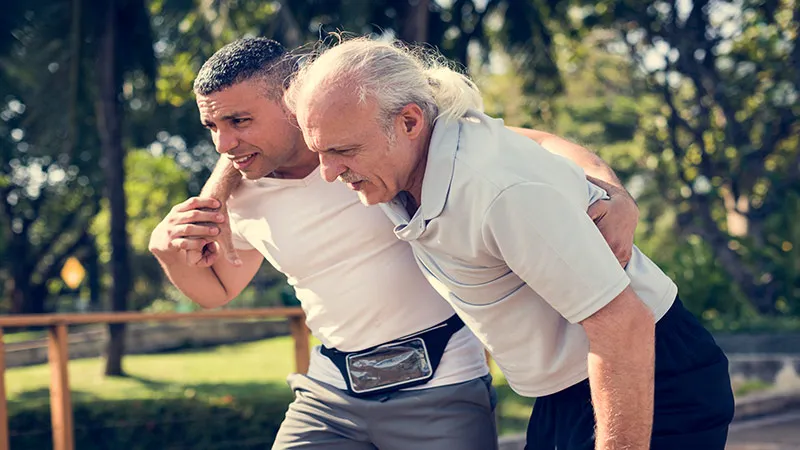First Aid
What is the Primary Survey First Aid – Primary and Secondary Survey in First Aid
Prior detection and treatment of imminent or existing life threats can save a patient’s life. Of course, we cannot use any rash methods or tools as it’s a priority to ensure that nothing will further endanger the patient’s life. It’s a systematic approach in which we must adhere to a set of rules and regulations. The primary survey first aid treats any life-threatening illness that a victim may be suffering from in order of priority throughout the first stage of this process.
We conduct a secondary survey after the original survey. Accordingly, the second one is for less apparent conditions that may require rapid attention. Further, this assessment comprises a thorough head-to-toe examination.
But always remember to call 999 or any other relevant helpline before you start to work with the patient.
Today’s blog covers the definition of Primary Survey First Aid, different sorts of surveys, step-by-step instructions for using the method described above, and a few other relevant issues.
Table of Content
What is Primary Survey in First Aid?
In any first aid assessment, the primary survey (also known as the first aid primary survey) is the initial step. It’s a preliminary evaluation of the circumstance and the casualty’s needs that will help you decide whether you can approach and begin helping them without endangering yourself or anybody else.
Its purpose is to assist you in promptly determining whether the victim’s life is in immediate danger. Further, using the primary survey, you’ll be able to tell if someone has any injuries or illnesses that could be life-threatening and require quick attention.
Before going to further discussion, let us tell you that it’s always a good idea to keep a first aid kit near you.
When Should You Use a Primary Survey?
When you come across a mishap – someone who has been injured or has become sick – you must use the primary survey. This could be the result of a visible accident or occurrence, such as a fall, or it could be the result of a hidden cause, such as a long-term medical condition, such as diabetes. Anyone can use the primary survey to diagnose a casualty. If a qualified first responder is present, they will most likely conduct the initial assessment and then deliver any necessary treatment to the victim.
Note that qualified first responders must have completed at least 18 contact hours of practical training.
If a competent first responder is unavailable, some places may have a designated person on hand. At work, designated individuals are in charge of first-aid arrangements. If a first aider is absent due to some circumstances, the assigned person may be able to offer emergency cover, including conducting the initial survey, depending on the individual’s role and ability.
If someone needs first aid outside of a job, such as at your house, you can conduct the initial survey yourself if you are confident in your abilities. This step could save lives. Therefore it’s critical that you know how to conduct the primary survey and deal with any life-threatening concerns before calling for aid.
Learn how many first aiders you need for your workplace, from this blog.
Do you need an Emergency First Aid at Work course?
What are the DRABC Steps and How Do I Use Them?
What is the DR ABC code and what does DRABC mean in first aid? Let’s talk about that.
What does DRABC Stand for in First Aid?
The primary survey should be completed in five steps, which can be memorised using the acronym DRABC. It stands for Danger, Response, Airway, Breathing and Circulation.
DRABC must be followed in the sequence listed to guarantee that the most life-threatening illnesses are identified and resolved first.
The five steps (primary survey checklist) are as follows:
- Danger
- Response
- Airway
- Breathing
- Circulation
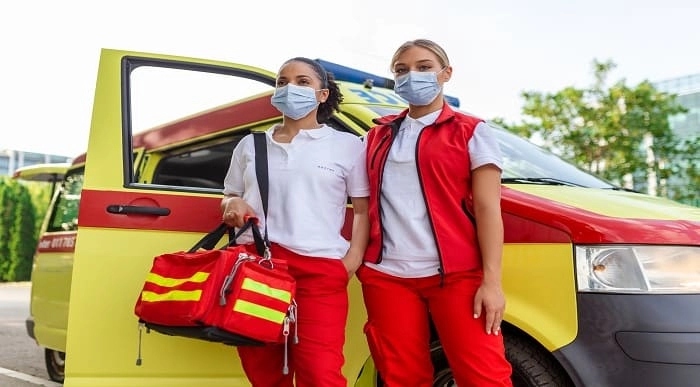
First Aid at Workplace
- Accredited Courses
- Tutor Support Included
- 3 Installment Plan at checkout
- 14 Days Money Back Guarantee
D Stands for Danger
The primary survey’s initial phase is to analyse the situation for any potential threat. It is critical that you do this first in order to guarantee that approaching the victim is safe for you. This means you must search the area for anything that could pose a threat to you, the casualty, or anybody else in the vicinity.
The following are a few examples of things that could pose a threat:
- Vehicles on the move.
- Shattered glass.
- An electrical current that is alive.
- Smoke or fire.
If any of these or other possible threats are discovered, you must attempt to make the surroundings safe before approaching the casualty.
For example, if there is a live wire current, you may be able to turn off the power at the starting point. However, if this isn’t possible, try moving the casualty with anything that doesn’t transmit electricity, like wood or plastic. You must not come into direct contact with the casualty.
You can easily contact the casualty once you have made the surroundings safe or if there are no threats, to begin with. If you are not able to make the location safe, contact for emergency medical aid instead of approaching the victim.
R Stands for Response
Once you’ve established that approaching the casualty is safe, you should see if they’re responsive. You can do this by inquiring if they’re okay, telling them to look at you, or asking them to raise their hand.
If the casualty speaks or moves in response to you, you should tend to any injuries or diseases they may have before proceeding to the following stage.
If the victim does not reply, try pressing them on the arm or lightly shaking their shoulder. You must not vigorously shake them, as this may aggravate any possible neck or back issues. If the casualty still doesn’t respond, proceed on to the next phase of the primary survey. If the emergency responders haven’t previously been contacted, call for assistance from them.
A Stands for Airway
The third phase of the primary survey is to make sure the casualty’s airway is clear of blockages and open.
If the casualty is unresponsive, you should:
- Place your hand on their forehead and lightly lean back their head, elevating their chin. Check for any obstructions in their airway visually.
- Remove any visible impediments with care. If you can’t see anything, don’t put your fingers in their mouth to open the airway since you risk pushing a potential blockage farther down.
- Immediately go on to the next level of the primary survey.
If the victim is receptive, you should:
- Examine their airway for anything that could trigger them to choke.
- You should urge them to clear any evident blockages with their hands or coughing.
- You must assist them in removing the blockage if they are not able to do so themselves and are badly choking. You should not place your fingers into their mouth in order to do so. Instead, give choking adults and children a mix of back-slapping and abdominal thrusts, and infants under one year old a combination of back strikes and chest thrusts.
- Once the blockage has been cleared, move on to the next stage of the primary survey.
B Stands for Breathing
The next step is to see if the victim is breathing properly. Check, hear, and feel for their breathing by leaning their head back, watching for chest movement, and listening for breathing noises. For 10 seconds, feel your cheek for air coming from their lips or nose. It’s critical to check for breathing for 10 seconds to ensure that it’s regular and rhythmic.
If the victim is breathing properly, proceed to the primary survey’s final step.
You must guarantee that the emergency crews have been called if the person is not responsive and not breathing regularly.
Start giving Cardiopulmonary resuscitation (CPR) with rescue breaths if you have had basic first aid training and are competent. If you haven’t got any hands-on training, you should perform CPR with only your hands and no rescue breaths. However, if one is accessible, have someone else identify and fetch a defibrillator (AED) for you to use.
How to Perform Cardiopulmonary resuscitation?
You should perform CPR cycles in two minutes – one cycle is 30 compressions and two rescue breaths. CPR should be performed five times in two minutes to be effective.
Top Courses of this Category
C Stands for Circulation
If the victim begins to breathe independently, you should proceed to the final stage of the primary survey. Further, this stage requires you to examine the casualty for evidence of serious bleeding.
You must control and minimise the bleeding if the wounded is bleeding profusely. If feasible, use a sterile dressing or a clean cloth to provide direct pressure to the wound. However, if you haven’t already done so, make sure the emergency crews have been contacted.
Moreover, if they aren’t bleeding heavily and you’ve completed the previous parts of the primary evaluation, attempt to reassure them that help is on the way. Keep an eye on them until medical assistance arrives.
You must place the casualty in the recovery position if they are not bleeding but are unresponsive and breathing properly. Next, if they vomit, this will keep their airway open and prevent them from choking. If you haven’t already done so, contact the emergency services.
You can proceed to the secondary survey after you’ve finished the primary survey and treated any life-threatening conditions.
What is Secondary Survey in First Aid?
Although our topic at hand is primary survey, it goes without saying that a secondary survey is deeply interconnected with it.
A Secondary Survey requires you to inquire about any incident that may have occurred with a responsive casualty and people around them. Your goal is to learn more about the victim’s:
Medical history,
Signs,
And symptoms
Keep a note of their responses if at all feasible.
Keep the casualty in the position you found until you’re sure it’s safe to move them to a more appropriate position for their illness or injury.
What to Find out in Medical History
When speaking with the victim, try to learn as much as you can about their medical history and current symptoms. Knowing this will assist you in determining what is problematic and how to treat it.
You can use the acronym ‘AMPLE’ to question the casualty about:
-
-
- Allergy
- Medication
- Previous medical history
- Last meal
- Event history
-
- A: Allergies, or allergic reactions, if they have any.
- M: Any Medication they take on a regular basis or that has been prescribed to them.
- P: Their medical history Prior to this.
- L: When was the Last time they ate something?
- E: What transpired before the Event that resulted in their injury or illness.
What are the Signs that Need to be Noticed?
Look for indicators of injury such as inflammation, deformities, bleeding, discolouration, or any strange odours by looking, listening, feeling, and smelling. Also, try to understand the level of consciousness that the patient is in. Conscious casualties often are less risky to work with.
When inspecting the victim, make sure to compare the wounded and unharmed sides of the body. In addition, you should try to determine if it is possible for them to stand or move their limbs in a normal manner. Make a note of any superficial injuries that need to be treated after you’ve concluded your assessment.
What are the Symptoms that Need to be Observed?
Short, uncomplicated inquiries regarding any symptoms the person is experiencing are appropriate. They should include as much information as feasible. For instance, you may ask them:
- Do you have any discomfort?
- What is the source of the discomfort?
- When did the discomfort begin?
- Is the pain persistent or erratic, severe or dull, and can you explain it?
- Is moving or breathing making the pain worse?
Recognise how long your first aid certificate can last with this blog.
Conclusion
In wrapping up, after reading this blog, you’ll have a general concept of primary and secondary surveys in first aid. Primary survey first aid will enable you to understand what to do if someone is lying on the floor in front of you.
FAQs
What is a primary injury survey?
Primary injury survey or primary survey in first aid is the same thing.
What is the purpose of primary survey?
The primary survey aims to quickly recognize and deal with potential or real hazards to the patient’s life.
What are the 5 key components of the primary survey in major trauma?
The 5 key components of the primary survey in major trauma are:
- Check for Danger
- Check Response
- Check for Open Airway
- Check Breathing
- Check for Circulation
What is primary survey and secondary survey?
The primary and secondary surveys provide comprehensive and logical features of patient evaluation. While primary survey should always be carried out first and is designed to discover and further prevent life-threatening injuries. A secondary survey is intended to be carried out once the patient is somewhat stable and involves fact-finding regarding what might have happened to the patient.
When should a primary survey and secondary survey be used?
Move on to a secondary survey after you’ve finished the primary survey and treated any life-threatening conditions.
What are the priorities of first aid?
Life preservation should always come first for first responders in any situation. To save the victim’s life, you might need to stop the bleeding, do CPR, or do anything else. Circulation, airway, and breathing (C-A-B) should come first.
What does a secondary survey include?
The secondary survey’s goal is to collect relevant history data about the patient and his or her condition, as well as to evaluate and treat injuries that were not discovered during the main survey.
How do you do a secondary survey?
A secondary survey should be done after the primary survey has been completed and the initial stabilisation has been completed. It includes doing a quick but thorough head-to-toe examination to rule out any possible injuries.
Should you complete the entire primary survey before starting to treat the casualty?
Yes, you should. The goal here is to keep the emergency responder as well as the victim safe from any unwanted situation.
What are the 3 P’s of first aid?
The 3 P’s in first aid stands for:
- Preserve life
- Prevent further injury
- Promote recovery
What does defibrillation mean?
Defibrillation means stopping the heart muscle fibrillation by delivering an shock across the chest with live electrical components, depolarising the heart cells and restoring normal rhythm.
What is the correct compression depth for CPR?
Place the heel of one hand on the person’s chest, then push down 5 to 6cm (2 to 2.5 inches) at a constant rate of 100 to 120 compressions per minute with the palm of the other hand on top. Give two rescue breaths after every 30 chest compressions.
What is the ratio for CPR in a child?
A 30:2 compression-to-ventilation ratio is used by a lone rescuer. If two rescuer is available, one provider should conduct chest compressions while the other keeps the airway open and performs ventilations in a 15:2 ratio.
Is CPR 15 compressions to 2 breaths?
Yes, this is done in the case of children. For an adult victim, two-person CPR will be 30 compressions to 2 breaths.
What are the three types of CPR?
CPR is divided into four levels: Level A, B, C, and BLS. Because the general public does not receive the same training as people in the medical industry, these levels are tailored to a specific audience.
What to Read Next:
- What does CPR stand for? A Comprehensive Overview
- What is Anaphylaxis – Causes & Symptoms
- How Many First Aiders Do I Need
- How Much Does a First Aid Course Cost? Course and Certificate Price



